|
Entry & Exit Guidelines
|
The skill of the exit is probably more important than the entry. My
Anaconda Exit Management System has
been shown to be profitable when only 45% of the trades are winners. Most people will lose money below
55% profitability because they trade too much size and wait too long to exit a loser. But exiting a loser
too soon will drop you winning percentage so low that you will also lose too much money. The key is to exit neither
too soon nor too late.
You need to give the trade some room to go against you or you will miss out on too many winners. The market has
a thing called "noise". It is just the randomness that increases as you look at smaller and smaller time frames.
Don't let the noise knock you out of a trade and always pay attention to the underlying trend. If you leverage
support and resistance then you can tighten up your exits.
|

|
If support is broken, then more selling is likely to be done and you should exit your long trade. If resistance is broken, then more
buying is likely to be executed as short sellers cover their positions. If you are short then you should exit. If you are long then
move up your stop loss.
You can see from the top right chart that price tends to travel to the next S/R level when an S/R level is broken. When an S/R level is broken then
the price tends to move quickly so you need to have your plan ready before the acceleration starts.
At the market open there is usually a complex adjustment that occurs in the first few minutes of trading where the S&P 500 Futures price and
the prices of the component stocks of the S&P 500 are brought into alignment through computerized arbitrage. During this time a reversal will
occur if the market has opened significantly higher ("Gap Up") or lower ("Gap Down") than it closed on the previous trading day (3-8 points on the
S&P 500). If the market opens a lot higher (more than 11 points on the S&P 500) then the reversal may not be very strong. I call
this the "Technical Reversal" and it usually occurs within the first five minutes of the open and is complete within the first 20 minutes.
If the market opens flat or nearly flat (less than 4 points difference on the S&P 500 from the previous day's close) then use the Tells to
decide your entry time. If you are going long then the action in the Tells should be bullish. If you are going short then the action in your specific
stock should be bearish, the overall market action and the Tell action is less important.
When entering long (buying) into a mildly bullish market you should wait for the Technical Reversal to make your entry. If the Technical Reversal goes too far
and becomes a real reversal, then consider exiting until it resolves itself (usually not more than 30 minutes). Do not buy into a declining market or
short into a rising market; wait for the turn to occur before you pull the trigger.
If the open is very bullish (more than 11 points up) then get in ASAP if you are planning to get in. If you are short and want out then get out ASAP.
If the open is very bearish (more than 11 points down) then get out ASAP if you want out of a long position. If you want to go long then wait until
the afternoon. If you are short then you may want to consider taking profits before the market closes.
An Exchange Sweep occurs when a big order suddenly cleans out all the bids or offers within a price range across all the markets that a stock is traded in. This will
cause a very brief spike down or up in the price, depending on if it was a buy order or sell order. If you run with a live stop loss that is near the
current market price, then you may get taken out of your position by this spike. It is better to run with a live stop loss if your positions are
unattended, but if you are there to watch it then using a manual exit will avoid exposure to an Exchange Sweep. If an Exchange Sweep occurs then allow
10-30 seconds for the price to recover. If it has not recovered by then or if it is trending out of control then you should exit.
|